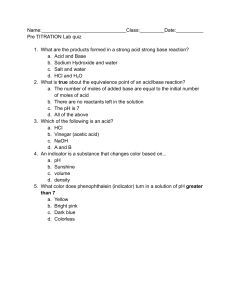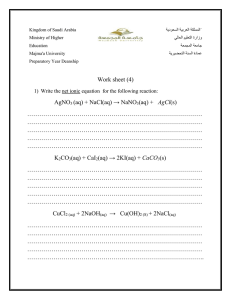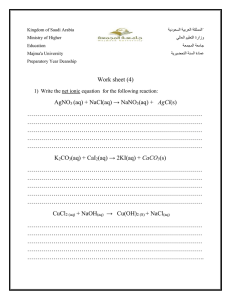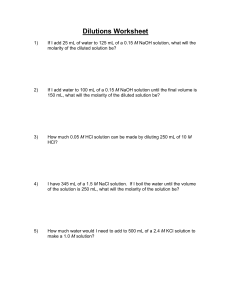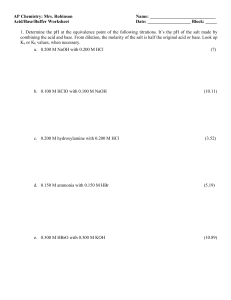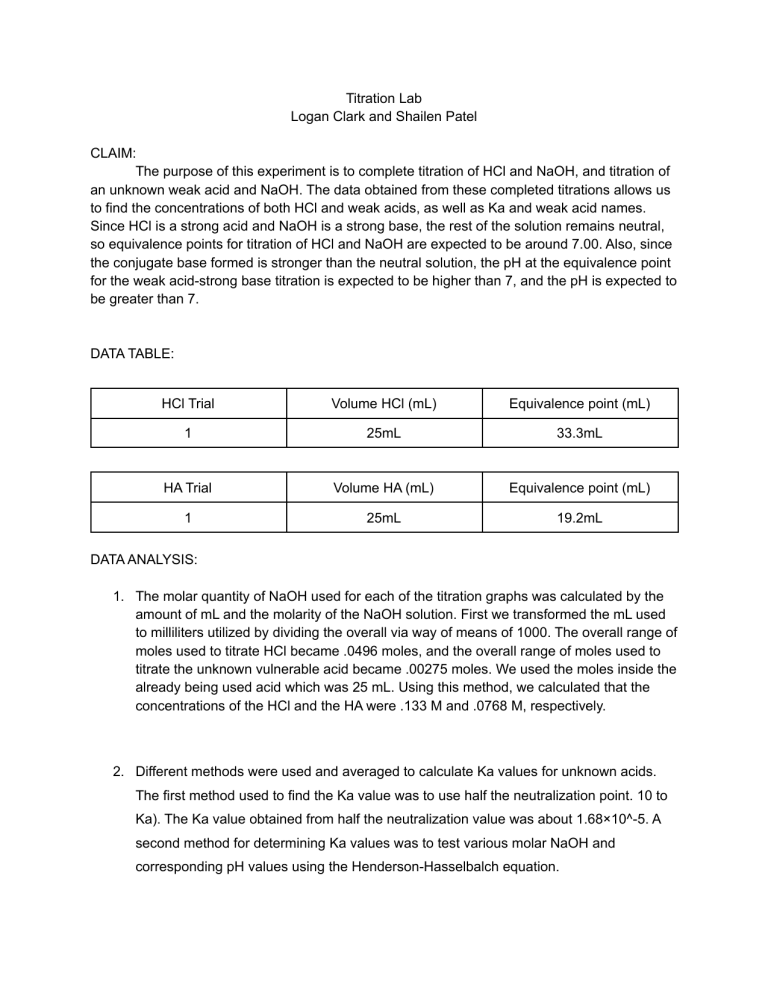
Titration Lab Logan Clark and Shailen Patel CLAIM: The purpose of this experiment is to complete titration of HCl and NaOH, and titration of an unknown weak acid and NaOH. The data obtained from these completed titrations allows us to find the concentrations of both HCl and weak acids, as well as Ka and weak acid names. Since HCl is a strong acid and NaOH is a strong base, the rest of the solution remains neutral, so equivalence points for titration of HCl and NaOH are expected to be around 7.00. Also, since the conjugate base formed is stronger than the neutral solution, the pH at the equivalence point for the weak acid-strong base titration is expected to be higher than 7, and the pH is expected to be greater than 7. DATA TABLE: HCl Trial Volume HCl (mL) Equivalence point (mL) 1 25mL 33.3mL HA Trial Volume HA (mL) Equivalence point (mL) 1 25mL 19.2mL DATA ANALYSIS: 1. The molar quantity of NaOH used for each of the titration graphs was calculated by the amount of mL and the molarity of the NaOH solution. First we transformed the mL used to milliliters utilized by dividing the overall via way of means of 1000. The overall range of moles used to titrate HCl became .0496 moles, and the overall range of moles used to titrate the unknown vulnerable acid became .00275 moles. We used the moles inside the already being used acid which was 25 mL. Using this method, we calculated that the concentrations of the HCl and the HA were .133 M and .0768 M, respectively. 2. Different methods were used and averaged to calculate Ka values for unknown acids. The first method used to find the Ka value was to use half the neutralization point. 10 to Ka). The Ka value obtained from half the neutralization value was about 1.68×10^-5. A second method for determining Ka values was to test various molar NaOH and corresponding pH values using the Henderson-Hasselbalch equation. (33.3 ml NAOH added)(.100 M) = (25 mL HA)(Unknown molarity) 3.33mmol of NaOH/25 mL HA = 0.133M (19.2 ml NAOH added)(.100 M) = (25 mL HA)(Unknown molarity) 1.92mmol of NaOH/25 mL HA = 0.0768M 3. The acid that best matches up with the Ka value is acetic acid has a Ka value of around 1.8 x 10^-5. Our Ka values that we got from testing different points were consistently around 1.5x10^-5 to 1.6x10^-5. As well, the half neutralization point was 1.68 x 10^-5, the Ka average becomes closer to 1.8x10^-5. The final Ka is close to acetic acid. 4. The actual concentrations of acids were 0.125M for HCl and 0.085M for weak acids. The calculated values for each acid were 0.133 M for HCl and 0.0768 M for weak acids. Subtracting the collected data from the actual reported data yields a difference of 0.008 M for HCl and 0.0082 M for weak acids. .125M HCl - .133M HCl = difference of .008 M for HCl .085M HA - .0768M HA = difference of .0082 M for HA Then, by dividing the difference (in molarity) we obtain from the previous calculation, we can determine how big of a difference it is from the original values by this formula: difference (M) original value (M) Plugging in the values for each respective acid into the formula we get: .008M HCl .125M HCl .0082M HA .0855M HA HCl Graph Below NaOH Graph Above REASONING: Our claim was correct as the pH was greater than 7. We originally thought that the equivalence point of the strong acid/strong base solution would be almost exactly 7. The second part of our claim was correct. We predicted that the weak acid solution would be greater than 7 pH, and the value we found in our experiment closely resembled this. We were able to obtain these values through our testing. Both graphs show the equivalence point when there is a vertical line going upwards, for HCl it is at 33.3 mL and for NaOH it is at 19.2 mL. By using the indicators, which we used phenolphthalein to pinpoint the equivalence points and using a pH reader, the values could be determined. We then used these numbers for our calculations for data analysis which led us to our conclusions. Name During Lab CER Logan Clark Gathered Supplies and Assisted with procedures Claim, Helped with evidence and Proofreading Shailen Patel Gathered Supplies and Assisted with procedures Evidence and Reasoning
